With their prime location near South Beach and luxe cachet, the four gated Sunset Islands are home to some of Miami Beach's richest and most famous residents, from mega-developer Scott Robins to nightclub impresario David Grutman. In a neighborhood known for its epic sunset views, where homes sell for upward of $26 million, you'd think residents would spend their days happily relaxing in the lap of luxury.
Think again. In the past few months, one seemingly minor neighborhood proposal has turned the two southernmost islands, known as Sunset III and IV, into a full-on neighbor-versus-neighbor war zone. The item of contention: a proposed sidewalk.
“This whole fight is disgusting,” says Peter Luria, a former homeowners' association (HOA) board member who is in favor of a sidewalk for better access. “There have been many instances where pedestrians have almost been run over. We’re talking about safety here.”
Sunset Drive, which spans from Sunset Harbor to the Sunset Islands, is a busy throughway — and a popular route for pedestrians traveling to and from the islands. In February 2014, the City of Miami Beach approved and funded the construction of a sidewalk along Sunset Drive as part of a large-scale neighborhood renovation project involving utility, street, water, and sanitary improvements. According to the city and experts, the sidewalk was to provide access for people with disabilities and greater safety to pedestrians and would connect to the existing sidewalks on two Sunset Island bridges.
But almost two years later, there is nary a new sidewalk to be found. And what's more, Luria was recently ousted from the board.
That's because some residents balked in a big way earlier this year when design proposals for the sidewalk circulated. The proposed construction was not a subtle, tasteful path, they said, but a full-on, five-foot raised cement strip, designed to incorporate recommendations from disability rights groups, including the city’s Disability Access Committee.
Residents such as Jackie Lalonde, an HOA board member, said the proposed sidewalk doesn't fit with the feel of the neighborhood and would encroach on private property. She said it's unnecessary for a small island community with minimal traffic.
“It’s part of this neighborhood’s historic nature to have grassy knolls and plants, as it is with virtually every other island on Miami Beach,” Lalonde says. “This type of sidewalk would completely recharacterize our island and impede on the historical look and value.”
In August, opposition hit a fever pitch. After receiving a steady stream of emails from irate residents, Miami Beach City Manager Jimmy Morales wrote to Mayor Philip Levine and the commission recommending the removal of the sidewalk from the plan, stating, “The community has requested the elimination of the proposed sidewalk from the project scope.”
Luria, whose family owned a jewelry and retail chain, says the supposed “community” Morales referred to was not a full representation of the residents or board members. Many are in favor, he says, including former HOA President Terry Bienstock.
Last month, the HOA board voted to oust Luria and Bienstock based on their “misguided ideas.” Mayor Levine’s friend and developer Scott Robins was added to the board and put in charge of working with the city on the issue, advocating for an extended shoulder in place of a sidewalk.
At a December 9 Miami Beach commission meeting, Mayor Levine berated Luria and reminded him he'd already been kicked off the HOA board in a "Venezuelan election."
Lalonde says tensions are certainly high in the neighborhood, but she trusts that the issue will get worked out — and that the community will be happy with the final result.
“We will create something that fulfills the needs of pedestrians and keeps with the historic nature of the island,” Lalonde says. “And I think everyone will eventually get over this because we’ve always been a pretty homogenous, peaceful community until now.”
Meanwhile, Luria isn't letting up. He says he plans to keep pushing for the sidewalk.
“Unfortunately, there are now people in the neighborhood who aren’t speaking to each other over this,” he says. “But this is about safety and our responsibility to the community. It's just about doing what's right.”
[
{
"name": "Air - MediumRectangle - Inline Content - Mobile Display Size",
"component": "19274298",
"insertPoint": "2",
"requiredCountToDisplay": "2"
},{
"name": "Editor Picks",
"component": "17482312",
"insertPoint": "4",
"requiredCountToDisplay": "1"
},{
"name": "Inline Links",
"component": "18711090",
"insertPoint": "8th",
"startingPoint": 8,
"requiredCountToDisplay": "7",
"maxInsertions": 25
},{
"name": "Air - MediumRectangle - Combo - Inline Content",
"component": "17482310",
"insertPoint": "8th",
"startingPoint": 8,
"requiredCountToDisplay": "7",
"maxInsertions": 25
},{
"name": "Inline Links",
"component": "18711090",
"insertPoint": "8th",
"startingPoint": 12,
"requiredCountToDisplay": "11",
"maxInsertions": 25
},{
"name": "Air - Leaderboard Tower - Combo - Inline Content",
"component": "17482313",
"insertPoint": "8th",
"startingPoint": 12,
"requiredCountToDisplay": "11",
"maxInsertions": 25
}
]










